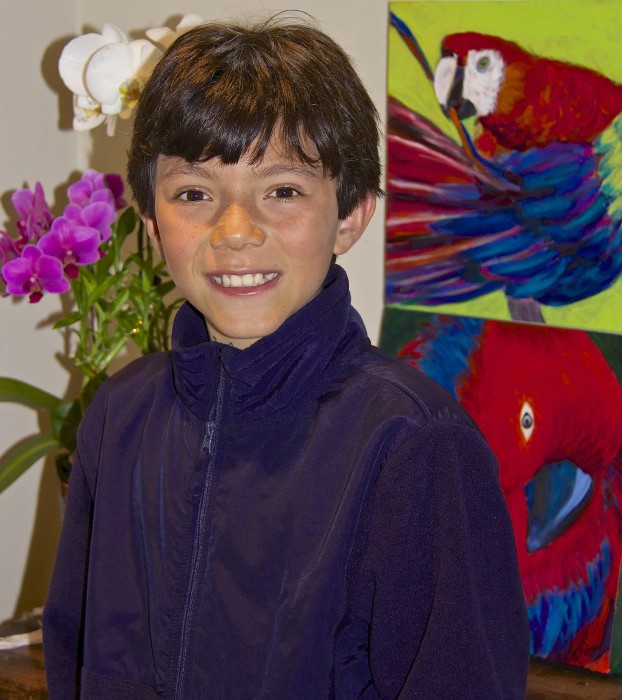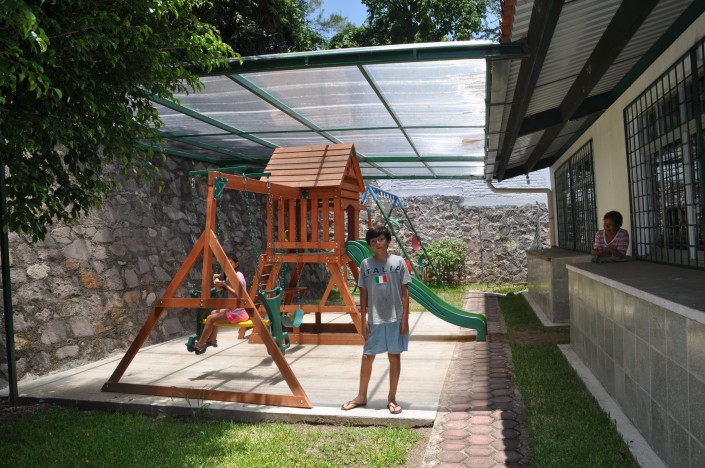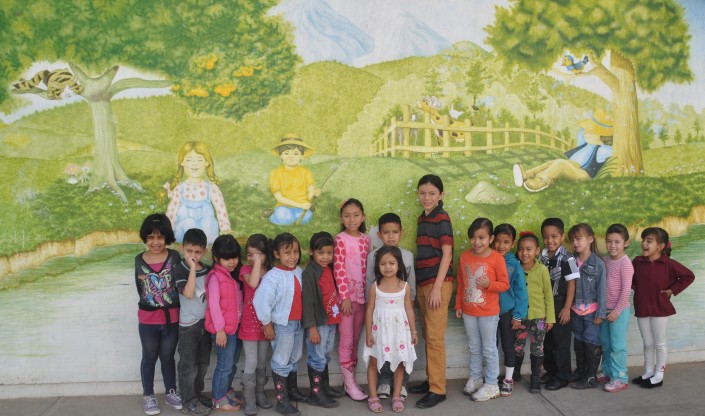
In 2011, Hurricane Jova, destroyed parts of the village of El Limón in Jalisco, Mexico. At the time, third grader, Elian “Miztli” Corona, learned of this from his grandmother, who lives there. He wanted to do something, but wasn’t quite sure what to do.
A conversation with the village President helped him identify the need for a wall separating the local kindergarten (home to one kindergarten and two pre-K classes) and the neighboring house. With the wall blown down, the kids couldn’t go out and play without adult supervision and the neighboring dogs didn’t let the kids play in peace either.
Now 11, Miztli will be entering sixth grade at Santa Catalina this fall. Three years and two village Presidents later, he’s completed his project. Although he was given the opportunity by the Presidents to use the funds he was raising for something else, he was determined to finish what he started.
Miztli’s generous spirit, steadfast determination, and exuberance are evident throughout our long interview. I hope you’ll enjoy his story as much as I did.
Deborah: Tell me about your project in Mexico. How did it all start?
Miztli: Well, in third grade, I heard about a hurricane in Mexico that had destroyed a kindergarten. I really wanted to help so I got together a couple friends and we started the project. I started asking people nicely for money and stuff like that….
So, in Mexico, we bought a pool. We were trying to extend the property. We had to go to the capitol building of that town and my mom had to take care of some papers. I was left…in the lobby….I started talking with the secretary and eventually I started talking to the President about my ideas. Eventually my mom came back and she couldn’t find me. The secretary told her I was talking to the President. [My mom] was like “what?”
D: So the President helped you understand what the needs of the community were?
M: Yes, because I wasn’t sure what the community needed. I knew I wanted to help, but I didn’t know how I was going to help until I talked to the President and he told me that the kindergarten needed help.
The President of the town said he would help me. He told me that my part was to raise the money and he would take care of the job. And if there was extra money needed, he would pay for it. That was the good part. He did help a lot. When I went there, I spent a day with the kids and played with them.

By the time I finished the project, the person neighboring the kindergarten had put up their own wall. They said that would be okay for a little bit. Their play equipment doesn’t have a roof over it. It gets really blazing hot in Mexico and it’s old-fashioned metal equipment. It gets burning hot and the kids can’t go play. They’re in kindergarten so they really want to play on the equipment. They really want to go down the slide, but they can’t because they’d get burned on the hot metal. I raised enough money to put a cover above the equipment, so the kids can play even if it’s blazing hot. [Note: Following a visit this summer, Miztli’s mother reports that the cover is impressive—a metal frame with a gutter for water run off and a cover that allows sunshine in and protects from the hot sun and heavy rain.] I’m happy with what I got. It wasn’t my first intention, but at least it was similar, and the school got some of their biggest needs [taken care of].
D: So, you’ve been working on this for three years. How much money did you raise?
M: $3,000. There’s an organization in Mexico for the Jalisco state—Club Unidos—that represents all the tiny little towns. They are in LA. I heard of this group and went to a meeting in LA, as well as a visit to our grandma who lives [there]. We talked to them and I presented my ideas. They really liked it and contributed $300, which is a lot for one day.
D: How did your friends help you?
M: In third grade, my friend stayed with me and helped me make stuff for the project. We had a movie night and…made posters.
D: Did any of your other friends help you along the way?
M: I had another friend who helped in fifth grade.
D: So mainly it’s been a project you’ve done on your own?
M: Yes, mainly on my own. But the community definitely helped more.
D: What other kind of activities did you do?
M: I think that’s about it, but we did walk around asking people for money. We made a box that we put the money in. It was heart-shaped.
D: Eventually you got to go to this region in Mexico and help, right?
M: Yes, because that’s where I’m from.
D: So that’s why this was such a special project for you.
M: Yes.
D: Do you visit every year?
M: Yes, we visit every year and we’re going back in about two weeks.
D: So you have a personal connection with this place?
M: Yes, I do. I went there for one day when I was younger. I was born here. But I went there for a day to try school in Mexico. I didn’t like it.
D: Why didn’t you like it?
M: I was used to school here.
D: What did your mom and dad say when you said you wanted to do this?
M: I think they were surprised.

D: What was your favorite part of this entire experience?
M: My favorite part might have been either spending the day with the kindergarteners. That was really fun. And also just working on it at school. In third grade, I remember it was really fun to just walk around and ask people to help me.
D: How did most people respond to you?
M: Most people were really like “Whoa, is this kid doing this?” Most of them helped and the ones that couldn’t promised to help in other ways, like they’d give me a schoolbook or something.
D: Now that this project is done, do you want to do something else?
M: I was thinking since this project’s over, I’m thinking of doing a smaller one. I’d go look for any other place that needs help and start another one. It’s been really hard and I don’t know if I want to do that again, but I might look in the newspaper [and see] if anybody needs help. I raised $300 pretty quickly. I started in May and raised that much by August. So I might just look for something that needs $200.
D: It’s nice to see that a small amount of money can make a difference, isn’t it?
M: Yes. Like $50 could help someone get a bunch of shots that they need. Or could help remodel an assisted care place. If everybody gave $50 it would be a lot. Or if everybody gave $1 and 100 people gave one dollar, it would be $100.
D: I like your thinking. You recognize that there’s power in multiple small gifts. What do you say to keep yourself motivated when you get overwhelmed?
M: I like to take a break and do something that I actually enjoy like play football. Then I come back to it later and I’ll be nice and calm and happy and I’ll have energy. If I get frustrated again, I’ll just go do something else. Sometimes that break will only be an hour. Sometimes it will be a week. It depends on how fast I can get back to it too.
D: When I first met you and your dad, he was telling me how you got your hair cut for Locks of Love. Tell me what inspired you to do that.
M: I just kinda wanted to grow my hair out and so I did. For Santa Catalina I can’t have long hair, so I thought, “why not just donate it?”
D: How did you hear about Locks of Love?
M: I think a bunch of kids at our school had done it. And I thought of it because I’d heard of it.
D: Have there been other projects like this that you’ve done?
M: No, just this.
D: Who influences you in your giving? How did you learn about giving?
M: I just kind of thought of it. No one really helped me. I just thought I could help. I’ll do it.
D: So, had you done any other giving with your parents or grandparents before this? Did you volunteer somewhere?
M: I don’t think so. I’ve always liked helping. The first thing I always do when I walk into the classroom is ask my teacher if she or he needs help with anything. I just do that. I always like talking with people and just helping. If I notice there’s somebody who needs help, I’m probably the first one to go up and help them.
D: What do you like best about giving?
M: It just feels good once you’re done. It feels like you start something and then you get really overwhelmed. It feels really good to say, “I helped. I did good. I helped everybody and I finished the project I started.”
D: If you could make any difference in the world, what would you want it to be?
M: I just like helping. So, I don’t know. It might be traveling the world. I really like photography. I might take pictures of animals and sell them and use the money to help a charity or remodel an assisted living facility or get food for people who need it.
When I asked Miztli how he learned about giving, his mother chimed in and said that the whole family has learned about giving, even Miztli’s little sister, through this project. What an important reminder that it’s a great way for a family to bond—give and volunteer together!
For more about Miztli and his project, read this article in the Cedar Street Times.
